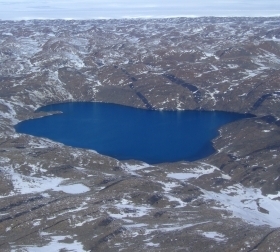Antarctica's promiscuous microbes
Wednesday, 02 October, 2013
Deep Lake, located 5 km from Davis Station in Antarctica, is 3500 years old, 36 m deep and so salty that it remains in liquid form down to a temperature of -20°C. Researchers have now uncovered the secrets of the lake’s dominant inhabitants - extremophile microbes from the haloarchaea group.

The research was led by Professor Rick Cavicchioli of the UNSW School of Biotechnology and Biomolecular Sciences and included other researchers from UNSW, the University of Tasmania, Charles Sturt University, the Los Alamos National Laboratory in the US and the US Department of Energy Joint Genome Institute (DOE JGI). Their work has been published in the Proceedings of the National Academy of Sciences.
Haloarchaea require high salt concentrations to grow and are naturally adapted to conditions that would prove lethally cold to other organisms. The team took water samples from the lake at various depths and studied the entire genome of the microbes living there to work out how they had evolved to cope with the conditions.
“Haloarchaea are known for being ‘promiscuous’, that is, prone to exchange DNA between themselves,” said Professor Cavicchioli. He said the process usually occurs infrequently, but the research showed “these ones swap much more genetic material with each other than has been observed in the natural environment before. Long stretches of virtually identical DNA [up to 35 kb] are exchanged between different genera, not just species.”
Tanja Woyke, microbial program lead at the DOE JGI and co-author of the study, said the researchers actually wondered if the long stretches of highly identical shared sequence between organisms were a result of cross-contamination. By analysing the genomes they were able to confirm that not only was this a “true inter-genera gene exchange”, she said, but that it reveals the microbes’ ability to survive.
“As the content being shifted around lack core genes, it speaks to these microbes’ ability to be flexible and collaborative,” Professor Cavicchioli said. “This shuttled gene content could confer such benefits as resistance to viruses or bolster their ability to respond to specific environmental factors.”
Yet despite the gene exchange, the lineage of each species is maintained as each has a high level of specialisation, having “evolved to exploit different niches and consume different food sources”, Professor Cavicchioli said. This allows for a peaceful co-existence.
The lake is one of the least productive environments on the planet with respect to synthesis of organic compounds from carbon dioxide, with only about six generations of cell division per year. The microbial species dubbed ‘tADL’, representing about 44% of the cell content of the community, has comparatively ‘high energy’ metabolism, which makes it adept at degrading carbohydrates. It has a particular taste for glycerol, a by-product of light-harvesting algae.
The results of the study are fascinating in themselves, but they also have the potential to assist in a variety of industrial applications.
“Enzymes from cold-adapted microbes could have significant value,” said Professor Cavicchioli. “Their high activity in cold temperatures could provide reduced energy costs for processes that would otherwise require heating, such as cleaning, or which must be carried out at cold temperatures, such as food production or bioremediation of cold, contaminated sites.”
As salt-loving enzymes can function under extremes, Professor Cavicchioli further suggests that they could be used as catalysts for peptide synthesis and enhanced oil recovery, and function in water-organic solvent mixtures. “These enzymes will be especially useful for transforming contaminated sites with particularly high levels of petroleum-based products,” he said.
With Professor Cavicchioli’s team having made this and other discoveries in Antarctic lakes, he said their work “illustrates just how valuable and unique Antarctic lakes can be and why Antarctica needs to be protected so societies the world over can benefit for years to come”.
Droplet microfluidics for single-cell analysis
Discover how droplet microfluidics is revolutionising single-cell analysis and selection in...
PCR alternative offers diagnostic testing in a handheld device
Researchers have developed a diagnostic platform that uses similar techniques to PCR, but within...
Urine test enables non-invasive bladder cancer detection
Researchers have developed a streamlined and simplified DNA-based urine test to improve early...




